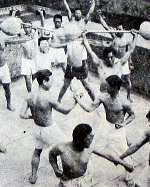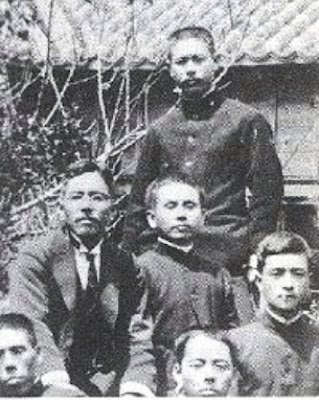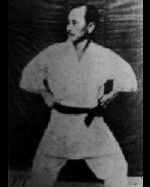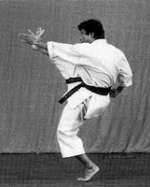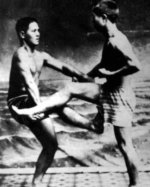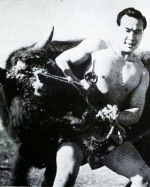Hironori Otsuka - Founder of Wado-Ryu Karate
Talk the Talk
The Japanese writing (kanji) for Wado can be translated two ways, as either Way of Peace or Japanese Way and Ryu means School.
Therefore Wado-Ryu
can be said to translate to, The School of the Way of Peace or to The School of the Japanese Way.
Walk the Walk
In 1966, Hironori Otsuka was awarded the Kun Goto Soukuo Kyokujujitsu (comparable to a knighthood) by Emperor Hirohito for his dedication to the development and teaching of karate.Later in 1972, he was further honoured for his achievements by the President of the Kokusai Budo Renmei (International Martial Arts Federation), when he was
awarded a Tenth Dan and the title of Meijin (brilliant man).
The title of Meijin is reserved for people who stand out as the strongest participant in their particular
field and was awarded to him by Prince Higashi Kuni No Miya, the younger brother of the emperor.
Karate Quote
"The difference between the possible and the impossible is one’s will".~ Hironori Otsuka ~

Hironori Otsuka was born in Shimodate City, Japan on June 1, 1892, and began his martial arts training at a young age.
Hironori Otsuka and Jujitsu
Chojiro Ebashi, an uncle of the young Otsuka, began teaching him jujitsu and by the age of five, he was learning Shindo Yoshin Ryu jujitsu under the tutelage of Shinzaburo Nakayama, the third Grand Master of the style. Shindo Yoshin emphasises the importance of grace and the natural flow of movement.
It was inspired when its founder, Yoshitoki Akiyama, observed how while the more ridged trees would often fall, the willow would survive even the harshest winters by bending and flowing with the elements rather than working in opposition to them. This concept stuck with Otsuka and the idea of using an opponent’s own movement and energy against him became an integral part of his martial arts philosophy.
From 1910 Otsuka attended Waseda University and while there, studied several styles of jujitsu and other martial arts, drawing the best techniques from them and even innovating some of his own. Not content with just learning self-defence, he also became adept at healing through manipulation of the body’s vital points and the art of bone setting. After the death of his father in 1913, he was forced to quit university and become a banker but continued to excel at martial arts. In 1920 at the age of twenty-eight, he obtained the highest rank in Shindo Yoshin Ryu jujitsu which enabled him to succeed Shinzaburo Nakayama to become the fourth Grand Master of the style.
Hironori Otsuka and Gichin Funakoshi
Master Otsuka was first introduced to karate in 1922 when Gichin Funakoshi, who would later found Shotokan karate, was invited by the Japanese Education Department to demonstrate his style of Okinawan martial arts, (then known as tode or te). Impressed with the spirit of this newly introduced art, Otsuka met with Funakoshi and soon after became his student.
Within a year, he had learned all of the fifteen kata Funakoshi had to teach though some of the movements and techniques were difficult at first for Otsuka to interpret. To further his knowledge, he also learned kata from Kenwa Mabuni, another well-respected Okinawan martial artist who would go on to found Shito-Ryu karate.
Otsuka excelled at karate and as well as being the chief instructor of Shindo Yoshin Ryu jujitsu, he also became an assistant instructor at Funakoshi’s dojo in Japan. However, while Otsuka loved kata, he believed karate training held too much emphasis on it so developed yakusoko kumite (pre-arranged fighting with a partner) in order to bring a more offensive and fluid type of training to the art. In May 1924, he and Funakoshi demonstrated yakusoko kumite for the first time, after which it became a fundamental part of the syllabus at Funakoshi’s dojos.
Towards the end of the 1920s, conflicts emerged between Gichin Funakoshi and his assistant instructor over the introduction of jujitsu techniques and the practice of jyu kumite (free sparring), which Funakoshi did not approve of; soon after Otsuka would leave his master’s school in order concentrate on developing his own style.
The Early History of Wado-Ryu Karate
This new style was recognised as an independent system in May 1934, though at this time was known as the Dai Nippon Karate-Do Shinko Club. The following year on the recommendation of Kano Jigoro, the founder of Judo, karate was recognised as a martial art in Japan though initially as an extension of judo. In 1939 the governing body of Japanese martial arts, the Dai Nippon Butoku Kai, requested all karate styles be registered and it was at this point that Otsuka officially registered the name Wado-Ryu.
Three major concepts can be said to make Hironori Otsuka’s karate stand out from other systems, they are:
- Nagasu - The ability to deflect an attack without using harsh blocks
- Inasu - The ability to move the body out of the line of attack while simultaneously using defensive and offensive techniques
- Noru - The ability to judge the effectiveness of a counterattack while an oncoming attack is still in progress
In contrast with most karate styles, the stances in Wado-Ryu when training are high to encourage speed whereas with other styles, lower stances are used within the kata and during training to help strengthen the legs. Otsuka also believed that there was no need to have too many kata within karate and in his book Karate-do Vol.1 published in 1970, he changed Wado-Ryu history by standardised nine kata, which were the five Pinan kata, Naifanchi, Seishan, Kushanku and Chinto. In the book, he stated, “Wado-Ryu has only nine katas, which is already too many if you want to train seriously.”
However, over time, perhaps largely due to competing in tournaments against other styles, many Wado-Ryu karate instructors added other kata to the syllabus and today, Bassai, Jion, Jitte, Niseishi and Rohai are all commonly practised by exponents of Master Otsuka’s style.
The Later History of Wado-Ryu
Wado-Ryu was a success from its early days and many new dojos soon sprung up early on in Japan, so much so that Otsuka became the head karate instructor for the country in 1944. Through the 1940s a number of future great masters began their karate training including Tatsuo Suzuki in 1943, Hironori Otsuka’s oldest son and namesake in 1945 and Teruo Konoin in 1947. The style continued to grow through the 1950s with the first All Japan Wado-Ryu Karate Championships being held in 1955.
The next major development in Wado-Ryu history came around 1963 when a team of three ambassadors from the Nihon University, Suzuki Tatsuo, Arakawa Toru, and Takashima Hajime, were sent to Europe and America to spread the teachings of karate. The art was a big hit and from around this time, representatives from all the major styles were systematically sent to the West to encourage the growth of karate.
In 1981, Sensei Otsuka decided to retire leaving his son as head of the Wado-Ryu organisation. This unfortunately caused somewhat of a rift and saw some high-level instructors brake away to form their own association. Just two months after his retirement, the great Master passed away on January 29, 1982, at the age of eighty-nine.
Despite the rift in the association that would ultimately leave the style with three main branches, Hironori Otsuka left a legacy that is practised by millions of people from all walks of life. Wado-Ryu is considered one of the four main styles of karate and is to this day one of the most popular and well-loved martial arts systems in the world.
Written by Andrew Griffiths – Last updated 22/06/2023. If you like
what you see, consider following the History of Fighting on social media.
Further Reading:
Donald Morris. [Internet]. 2009. Master Hironori Otsuka. Dojo Update. Available from: http://www.dojoupdate.com/wado-ryu-karate/master-hironori-otsuka [Accessed April 24, 2018].
History of Wado-Ryu. [Internet]. 2011. Queens University. Available from: http://www.wadoryukarate.club.qub.ac.uk/history%20of%20wado%20ryu.html# [Accessed April 24, 2018].
Mick McComb. [Internet]. 2001. History of Wado Ryu. Queens University. Available from: http://quis.qub.ac.uk/wadoryu/History.html [Accessed April 24, 2018].
Shingo Ohgami. [Internet]. 2018. History of Wadoryu Karate. Swiss Wadokai Karatedo Renmei. Available from: http://www.swkr.ch/english/wado-ryu.html [Accessed April 24, 2018].
The History of Wado Ryu - Ohtsuka Sensei Story. [Internet]. 2012. wikf.com. Available from: http://www.wikf.com/wado.php [Accessed April 24, 2018].
Wadoryu is not Karate. [Internet]. 2018. British Wadokai. Available from: http://www.wadokai.co.uk/wadoryu-is-not-karate.html [Accessed April 24, 2018].
More Karate History
Karate History Home
The history of karate begins in Okinawa, where martial arts were influenced by both kung fu from China, and the Japanese samurai. After weapons were banned on the island, unarmed combat techniques were developed into a style of fighting recognisable as traditional karate, which was further developed after being taken to Japan in the early twentieth century by Gichin Funakoshi.
The history of karate begins in Okinawa, where martial arts were influenced by both kung fu from China, and the Japanese samurai. After weapons were banned on the island, unarmed combat techniques were developed into a style of fighting recognisable as traditional karate, which was further developed after being taken to Japan in the early twentieth century by Gichin Funakoshi.
The History of Okinawan Karate
A look at the history of Okinawan karate and how it developed from the seventeenth century. Okinawan martial arts had influences from both the Japanese samurai and Chinese kung fu, as well as techniques unique to the island itself which over the years blended and evolved into the traditional karate styles that are practiced all over the world today.
A look at the history of Okinawan karate and how it developed from the seventeenth century. Okinawan martial arts had influences from both the Japanese samurai and Chinese kung fu, as well as techniques unique to the island itself which over the years blended and evolved into the traditional karate styles that are practiced all over the world today.
The Life and Legends of Anko Itosu
Anko Itosu was a legendary Okinawan martial artist and a pioneer in the development of karate history. He popularised many aspects of the fighting system through his Shuri-te style and helped increase the number of people who were permitted to learn it by bringing karate training out of secrecy, and even gained permission to teach it in Okinawan schools.
Anko Itosu was a legendary Okinawan martial artist and a pioneer in the development of karate history. He popularised many aspects of the fighting system through his Shuri-te style and helped increase the number of people who were permitted to learn it by bringing karate training out of secrecy, and even gained permission to teach it in Okinawan schools.
Gichin Funakoshi - Father of
Modern Day Karate
Gichin Funakoshi was born in Okinawa in 1868 and is known as the father of modern-day karate due to the innovations he made to Okinawan martial arts when he took it to Japan and popularised it with the people there. Not only did he found Shotokan karate, but he was also instrumental in spreading karate across the world.
Gichin Funakoshi was born in Okinawa in 1868 and is known as the father of modern-day karate due to the innovations he made to Okinawan martial arts when he took it to Japan and popularised it with the people there. Not only did he found Shotokan karate, but he was also instrumental in spreading karate across the world.
The History of the Shotokan Kata – Part One
A look at the history of the more basic Shotokan kata, including their origins, development, interesting facts and scholastic debate. This list of kata histories includes, Kihon kata, the Heian kata, the Tekki group, Bassai Dai and Sho, Empi, Hangetsu, Kanku Sho and Dai, Jion, Ji’in and Jitte and includes video links to the relevant kata.
A look at the history of the more basic Shotokan kata, including their origins, development, interesting facts and scholastic debate. This list of kata histories includes, Kihon kata, the Heian kata, the Tekki group, Bassai Dai and Sho, Empi, Hangetsu, Kanku Sho and Dai, Jion, Ji’in and Jitte and includes video links to the relevant kata.
The History of the Shotokan Kata – Part Two
A look at the history of the more advanced Shotokan kata, including their origins, development, interesting facts and debated issues. This list of karate kata histories includes, Wankan, Gankaku, Meikyo, Chinte, Gojushiho Sho and Dai, Sochin, Nijushiho and Unsu, and includes video links to the relevant kata.
A look at the history of the more advanced Shotokan kata, including their origins, development, interesting facts and debated issues. This list of karate kata histories includes, Wankan, Gankaku, Meikyo, Chinte, Gojushiho Sho and Dai, Sochin, Nijushiho and Unsu, and includes video links to the relevant kata.
Kenwa Mabuni – Founder of Shito-Ryu Karate
Kenwa Mabuni started life as a sickly child but transformed himself into a strong warrior through the practice and dedication to the martial arts. Through his studies with
great karate masters such as Anko Itosu and Kanryo Higaonna, along with the kung fu master Woo Yin Gue, he was able to combine what he had learned and develop one of the four
major styles of traditional karate, Shito-Ryu.
The Real Mr Miyagi – Founder of Goju Ryu
Sensei Chojun Miyagi was an early karate master who studied martial arts in both China and his homeland, Okinawa. He earned his place in martial arts history when he used his knowledge to blend soft (or internal) with hard (or external) techniques to develop the style known as Goju-Ryu, which is considered one of the main four styles and is today widely practiced throughout the world techniques.
Sensei Chojun Miyagi was an early karate master who studied martial arts in both China and his homeland, Okinawa. He earned his place in martial arts history when he used his knowledge to blend soft (or internal) with hard (or external) techniques to develop the style known as Goju-Ryu, which is considered one of the main four styles and is today widely practiced throughout the world techniques.
Mas Oyama – Founder of Kyokushin Karate
Mas Oyama, founder of Kyokushin karate was one of the best karate masters of all time. He developed his body, mind and techniques through rigorous training and fought and won hundreds of full contact battles against fighters from many different martial arts styles. To test his skills further, he also went head to head with 52 bulls and was victorious in all, whether against man or beast.
Mas Oyama, founder of Kyokushin karate was one of the best karate masters of all time. He developed his body, mind and techniques through rigorous training and fought and won hundreds of full contact battles against fighters from many different martial arts styles. To test his skills further, he also went head to head with 52 bulls and was victorious in all, whether against man or beast.
The images on this site are believed to be in the public domain, however, if any mistakes have been made and your copyright or intellectual rights have been breeched, please contact andrew@articlesonhistory.com.



